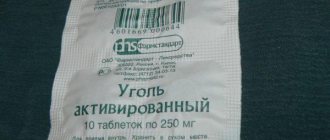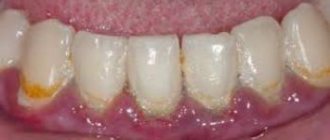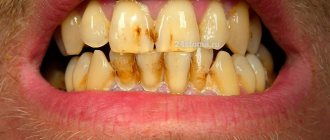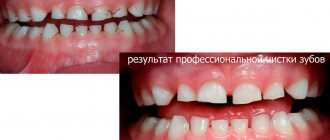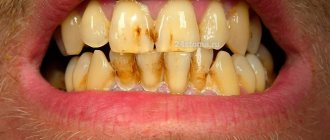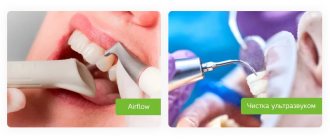Beautiful snow-white teeth are an important component of the image of a successful person. But for a number of reasons, the enamel becomes covered with an unaesthetic coating. This problem cannot be ignored, since soft plaque mineralizes and turns into tartar. It cannot be removed during normal oral hygiene. Deposits can only be removed by contacting the dentist.
If black plaque is not professionally removed , the patient will experience bad breath, darkening of the enamel, inflammation of the gums and the development of caries. As a result, he will have to treat the consequences that have arisen.
Why does plaque form on teeth?
Various factors can provoke the formation of plaque. It often consists of food debris, bacteria and is formed due to insufficient oral hygiene. But sometimes plaque appears even in those patients who regularly brush their teeth efficiently. Why? This is due to the darkening of the enamel under the influence of coloring pigments contained in coffee, strong black tea, and nicotine. In addition, a change in the aesthetic appearance of enamel is possible under the influence of certain medications, diseases of the liver, spleen, mouth rinses, as well as as a result of the activity of chromogenic bacteria (occurs in childhood).
Black plaque on teeth appears among workers in the metallurgical industry who daily inhale condensate containing microparticles of heavy metals. Units darken and collapse in people with drug addiction.
Dark plaque in children
In children, dark plaque on teeth can be caused by the following factors:
- chromogenic bacteria that produce pigments;
- diseases – dysbacteriosis, disruption of the digestive system;
- change of diet and usual products;
- hereditary predisposition;
- lack of calcium during fetal development and in the first months after birth;
- disruptions in the functioning of the immune system;
- dysfunction of the salivary glands;
- enamel hypoplasia and caries.
The cause of black plaque on a child’s teeth may be the so-called Priestley’s plaque. It occurs even on baby teeth and can appear at any age - both in teenagers and in very young children. Accompanied by an unpleasant odor from the mouth.
This phenomenon is a product of the vital activity of certain bacteria - a black pigment that settles on the enamel. It is safe for molars and for the body as a whole, does not provoke the development of pathologies and goes away on its own over time.
If we talk about how to remove dark plaque from a child’s teeth, professional hygienic cleaning will help, but it is not a guarantee that it will not appear again soon.
What to do?
Many people want to clean their teeth from plaque at home. To do this, they use special bleaching pastes, soda, activated carbon, 3% hydrogen peroxide solution, and lemon juice. Sometimes, with slight darkening of the enamel, these methods give the desired effect.
But if you abuse such bleaching, as well as in case of increased sensitivity of the enamel, you can only harm yourself. Therefore, if you want to return your teeth to a snow-white shade, you need to start with a visit to a specialist. The dentist will assess the condition of the enamel, identify diseases of the oral cavity (if any) and recommend the best option for cleaning teeth from plaque.
In a clinical setting, there are several ways to get rid of deposits. Let's consider them in as much detail as possible. This will allow you to go for a consultation with a “theoretical savvy” specialist.
About toothbrushes
Special toothbrushes will help remove dark plaque. The following types have proven themselves well.
Ultrasonic - they work on a special generator that produces vibrations. Their range is approximately 1.6 MHz. The waves act on the junction of dental plaque and enamel. This brush gets rid of darkening of the enamel and small supragingival tartar.
- Black teeth in children
Electric - these brushes are equipped with a working head on which the bristles are located. Its rotation and pulsations destroy the strong connection of pigment and mineral-bacterial layers on the surface of the enamel. And rotational movements help remove it.
Special brushes will help get rid of plaque
Professional Air Flow cleaning
This method is considered the most gentle on enamel and painless. The essence of the procedure is to influence deposits with a mixture of water, air and soda crystals, which is supplied under pressure. This way you can clean your teeth and the spaces between them.
The dentist recommends Air Flow cleaning to the patient in the following cases:
- the presence of plaque that turns into stone;
- discoloration of enamel caused by drinking strong tea, coffee, carbonated drinks, smoking;
- if it is necessary to install or remove crowns, braces, implants, high-quality cleaning of these systems;
- the presence of tightly spaced, twisted teeth in a row;
- the appearance of symptoms of periodontal disease.
Timely cleaning with such a device helps prevent the development of caries, gingivitis, periodontitis and periodontal disease. It allows you to effectively remove deposits on teeth, between units, even in the most inaccessible places, as well as on dental structures. At the same time, the enamel becomes lighter by 1-2 tones, pigment spots disappear. During polishing, the enamel is saturated with fluoride and strengthened.
Despite all the advantages of Air Flow, this procedure has a number of contraindications. In particular, it is not carried out when:
- severe pathologies of the respiratory system, including bronchial asthma;
- hepatitis;
- diabetes mellitus;
- tuberculosis;
- tendency to allergic reactions;
- HIV;
- infectious diseases;
- heart rhythm disturbances, presence of a pacemaker;
- increased sensitivity of enamel;
- the presence of areas of demineralization;
- installed titanium implants.
This method of professional cleaning is not recommended during pregnancy and lactation.
After the procedure, for 2-3 days the patient may complain of pain when eating cold and hot food. To reduce enamel sensitivity, you must use toothpaste labeled “Sensitive.” Be sure to buy a new brush with soft bristles.
During this period, it is better to exclude sour and sweet foods, cold and hot foods from the diet, refuse to drink carbonated drinks with dyes (including low-alcohol ones), coffee, strong black tea, and red wine. It is undesirable to eat red and orange fruits and vegetables.
Comments
Recently, my wisdom tooth, which had been in for sooo long, finally came through completely. But it came out black and ached a little when pressed. What could it be?
Alice (04/12/2020 at 5:14 pm) Reply to comment
- Dear Alice, perhaps the wisdom tooth was affected by caries, pulpitis or periodontitis even before it completely broke through. You need to be examined by a dentist to find out the cause of the problem and begin treatment. If treatment is not practical, the tooth will have to be removed.
Editorial staff of the portal UltraSmile.ru (04/17/2020 at 09:17) Reply to comment
I heard that some materials that dentists use to treat teeth can cause blackening of the enamel. Is this really so, what to fear during treatment?
Lyubov Vladimirovna (04.05.2020 at 12:21) Reply to comment
- Dear Lyubov Vladimirovna, in the past, dentistry actually used materials that could cause darkening of teeth, for example, silver amalgam fillings, but today they are not used, so treat your teeth without fear.
Editorial staff of the portal UltraSmile.ru (05/11/2020 at 09:20) Reply to comment
I have a very dark coating on my nylon dentures, can I bleach it?
Alexander Mikhailovich (05.28.2020 at 22:17) Reply to comment
- Dear Alexander Mikhailovich, nylon absorbs various dyes well and requires daily and very careful care. Unfortunately, artificial denture materials cannot be bleached. You, of course, can try to clean them with special tablets or take them to the dentist for professional cleaning, but such a measure will not remove deeply ingrained pigment; it will only remove superficial stains and destroy bacteria.
Editorial staff of the portal UltraSmile.ru (06.06.2020 at 14:09) Reply to comment
Write your comment Cancel reply
Ultrasonic cleaning with the “Vector” device
The German “Vector” system was created specifically to rid teeth of plaque. It effectively removes soft and hard mineralized deposits on the coronal part of units, as well as in periodontal pockets. The peculiarity of the procedure is the use of a special nozzle; ultrasound is applied strictly vertically (top to bottom and bottom to top). This allows you to remove deposits carefully, comfortably and painlessly. The entire process is controlled and predictable; during the procedure, the dentist adjusts the amplitude of the waves.
Thanks to the use of a special solution with hydroxyapatite granules, high-quality polishing of the surface of the crown and root occurs; after such cleaning, the appearance of new plaque occurs several times slower. In addition, the liquid promotes rapid regeneration of inflamed tissues, reduces sensitivity during the procedure and makes breathing fresh.
Plaque removal using the Vector device can be carried out when:
- gingivitis;
- periodontitis;
- identifying periodontal pockets 4-6 mm deep;
- increased sensitivity of teeth and gums;
- atrophic processes, exposure of the necks of units.
The procedure is contraindicated in childhood, during pregnancy and lactation, in the case of deep periodontal pockets filled with pus. Also, cleaning is not carried out if there is severe mobility of the units, the presence of malignant tumors in the body, severe heart disease, or if there is a pacemaker.
After the procedure, the doctor recommends using a new soft brush and toothpaste for sensitive teeth. In addition, you should give up coloring foods and drinks and smoking for 2-3 days.
Smoking cigarettes and cigars
Black-brown plaque, tightly adjacent to the necks of the teeth on the inside of the row, appears as a result of smoking. In the process of smoking a cigarette or cigar, resins and carcinogens are deposited on the enamel, which contribute to pigmentation. This bad habit provokes the emergence of many dangerous problems and dental diseases. Which ones? You can read more about this in the feature article on our website.
Do not forget that by consuming cigarettes, you expose the enamel to strong temperature changes, due to which it cracks, and any pigment from food and drinks gets into the cracks much more easily.
Notice
: Undefined variable: post_id in
/home/c/ch75405/public_html/wp-content/themes/UltraSmile/single-item.php
on line
45 Notice
: Undefined variable: full in
/home/c/ch75405/public_html/wp-content /themes/UltraSmile/single-item.php
on line
46
Rate this article:
( 1 ratings, average: 5.00 out of 5)
plaque
- Evteev S.S., Lebedeva S.N., Kharitonova T.L. Etiological factors of dental discoloration // Bulletin of medical Internet conferences. – 2022.
Expert “In order to prevent plaque from spoiling your smile, you need to undergo preventive examinations at the dentist and professional hygiene twice a year. It must be remembered that plaque can form not only on natural teeth, but also on artificial materials used for restorations. Restored teeth also require careful hygienic care.” Dentist-therapist Elina Ruslanovna Dzagurova
Consulting specialist
Dzagurova Elina Ruslanovna
Doctor rating: 9.5 out of 10 (2) Specialization: Dentist-therapist Experience: 11 years
Laser cleaning
This is an innovative, gentle and painless method of cleaning teeth from plaque of any color (black, yellow, etc.). During the procedure, the enamel is not damaged, and there is virtually no gum bleeding. Although this method of dealing with deposits is expensive, the investment is completely justified.
Benefits of laser teeth cleaning:
- removal of plaque and tartar, regardless of location;
- low level of pain, and therefore local anesthesia is not required;
- the ability to regulate the intensity of the impact;
- absence of noise and vibration, which is important for patients with dental phobia;
- non-contact - the device does not come into contact with tissues;
- safety of the procedure - the formation of enamel microcracks is excluded;
- no gum bleeding - even if tissue is damaged, the blood immediately coagulates under the influence of the laser;
- minimal risk of complications - the beam has a disinfecting effect, so during the procedure all pathogenic microorganisms are killed;
- rapid tissue restoration - due to stimulation of trophism and reparative processes;
- lightening the enamel by 1-3 tones;
- long-term effect - no plaque on the teeth for a year, provided proper care of the teeth and the oral cavity.
Laser deposit removal can only be performed by adults (over 18 years of age). It is not given to pregnant and lactating women if the patient has inflammation of the oral mucosa, severe heart pathologies or infectious diseases. Also contraindications are AIDS, HIV, bronchial asthma, chronic bronchitis.
Localization options
Black plaque can be located on various parts of the tooth surface.
Depending on the location and anatomical and topographical areas of fixation, it can be:
- Supragingival. Located on the exposed surface of the tooth.
- Subgingival. It is formed in the area of the lower edge of the periodontium in the gingival groove or in the gingival pocket along the rim of the tooth.
- Dentogingival. Localized on smooth tooth surfaces.
- Proximal. Located on the contact areas of tooth enamel.
- Epithelially attached. Fixed to the periodontal epithelium.
- Subgingival-tooth-attached. Affects the entire surface of the dentition.
The main location of black plaque is the spaces between the teeth, their inner surface and the area near the gums.
Black plaque in a child
Black plaque in an adult
Removing black plaque with ultrasound
Ultrasound is best used to remove black plaque if it has already caused the formation of tartar. Teeth are cleaned using a drill with a specific attachment.
Plaque is removed according to this scheme.
- A scaler attachment is installed on the equipment.
- A saliva ejector is placed in the mouth.
- The teeth are coated with an abrasive paste.
- The nozzle rotates at an ultrasonic frequency, and at the same time a thin stream of water flows onto the surface of the tooth enamel.
You can remove black plaque with ultrasound from a doctor
The advantage of this method is that it helps remove soft and hard plaque, as well as tartar. The downside is the lack of therapeutic effects. The procedure is usually carried out once every six months.
Important! If the pathogenic microflora is very active, then a fresh black formation can become denser in 3-4 months. So after 2 or 3 months, the teeth will again begin to be covered with dark plaque.
Contraindications to ultrasonic cleaning:
- infectious hepatitis;
- enamel erosion, foci of demineralization;
- use of pacemakers;
- HIV infection;
- tuberculosis;
- a number of heart diseases;
- dental implantation with titanium pins;
- diabetes;
- malocclusion in children;
- baby teeth.
There are contraindications to such cleaning
